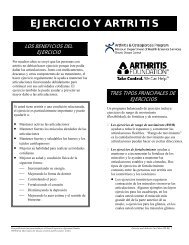Prevention and Control of Communicable Diseases - Missouri ...
Prevention and Control of Communicable Diseases - Missouri ...
Prevention and Control of Communicable Diseases - Missouri ...
Create successful ePaper yourself
Turn your PDF publications into a flip-book with our unique Google optimized e-Paper software.
July 2011<br />
HEPATITIS B<br />
Reportable to local or state health department<br />
This fact sheet is for provider information only.<br />
If you have questions, please call the health department.<br />
122<br />
PROVIDER<br />
It is rare for children to be infected with hepatitis B with the exception <strong>of</strong> those children infected by their<br />
mothers during pregnancy or childbirth. These children may have a lifelong infection (chronic infection).<br />
Children who have chronic hepatitis B infection may be attending childcare or school; however, spread <strong>of</strong><br />
hepatitis B in these settings is very rare.<br />
CAUSE Hepatitis B virus.<br />
SYMPTOMS Loss <strong>of</strong> appetite, tiredness, stomach pain, nausea, vomiting, dark (tea or<br />
cola-colored) urine, light-colored fecess, <strong>and</strong> sometime rash or joint pain. Jaundice<br />
(yellowing <strong>of</strong> eyes or skin) may be present in adults but it is uncommon in young<br />
children. Symptoms vary greatly from none at all to severe illness. Adults have<br />
symptoms more <strong>of</strong>ten than children.<br />
SPREAD Virus is present in the blood <strong>and</strong> other body fluids that may contain blood. It can<br />
be spread person-to-person when blood from an infected person enters an open cut<br />
or splashes into the eye or mouth <strong>of</strong> another person, by sharing any equipment to<br />
inject drugs or puncture the skin, such as tattooing or body piercing, or through<br />
sexual contact. Although virus can be found in saliva, the amount <strong>of</strong> virus in the<br />
saliva is so low that spread is very unlikely. It can also be spread from a mother to<br />
her baby during pregnancy or childbirth.<br />
INCUBATION It takes from 6 weeks to 6 months, usually 2 to 3 months, from the time a person is<br />
exposed to hepatitis B virus until disease occurs.<br />
CONTAGIOUS<br />
PERIOD<br />
May be infectious for many weeks before onset <strong>of</strong> symptoms <strong>and</strong> remain infectious<br />
for 4 to 6 months. Some people may have chronic hepatitis B infection <strong>and</strong> may<br />
be infectious for life.<br />
EXCLUSION Children with Hepatitis B infection should not be excluded from school, childcare,<br />
or other group care settings solely based on their Hepatitis B infection. Any child,<br />
regardless <strong>of</strong> known Hepatitis B status, who has a condition such as oozing sores<br />
that cannot be covered, bleeding problems, or unusually aggressive behavior (e.g.,<br />
biting) that cannot be controlled may merit assessment by the child’s health<br />
pr<strong>of</strong>essional <strong>and</strong> the child care program director or school principal to see whether<br />
the child may attend while the condition is present.<br />
DIAGNOSIS Hepatitis B can be diagnosed through blood tests.<br />
TREATMENT Recommend parents/guardians call their healthcare provider.<br />
PREVENTION/CONTROL<br />
� All children should receive the three dose hepatitis B vaccine series as part <strong>of</strong><br />
their routine immunizations.
















